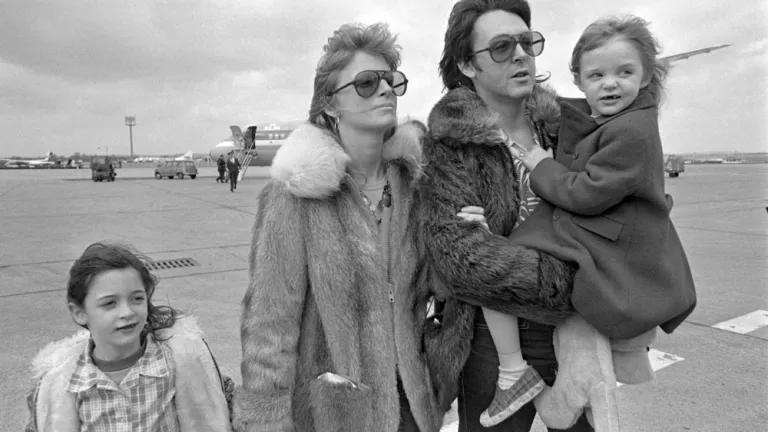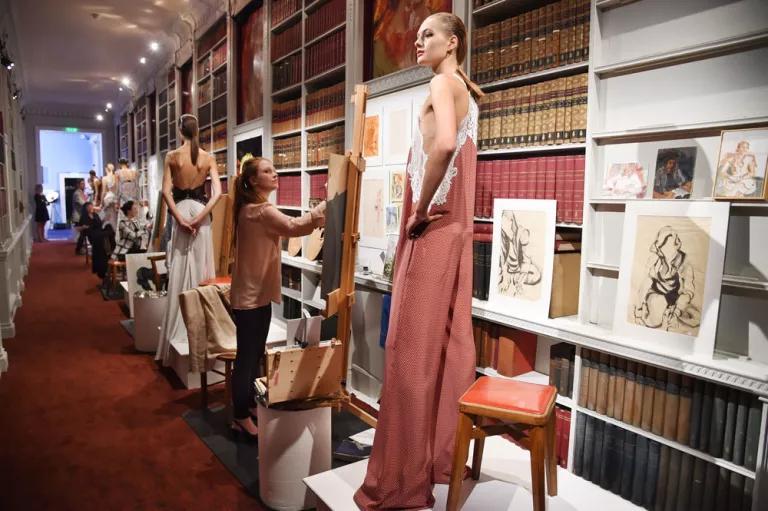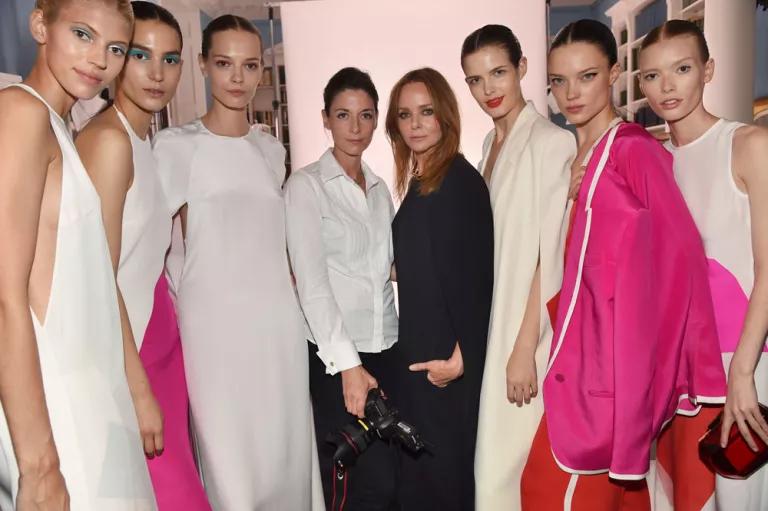On the Runway
Stella McCartney has risen to the top of the fashion world by adding just one more element to her sexy, sophisticated designs: sustainability. Can this trendsetter get an entire industry to follow her lead?

From the sidewalk, the West London headquarters of Stella McCartney is so nondescript that on the day I’m scheduled to visit, I walk right past the building—twice—before finally realizing that it bears the address I’m looking for. Inside, however, the interior conforms to my vision of what a top fashion designer’s office should look like: expansive planes of white punctuated by pops of bright color; a couch upholstered in sugary pink fabric; a twinkling neon sign that reads, simply, Stella; and many chic women briskly going about their business while sporting sophisticated, unfussy separates that read as feminine but definitely not “girly.”
I’ve come to learn more about McCartney, who at 43 has gone from being a young woman most famous for her celebrity lineage—her father was a Beatle; her mother was the photographer, musician, and animal-rights activist Linda McCartney—to occupying a singular position in the world of high-end apparel.
Her eponymous line of clothing, jewelry, and accessories brought in more than $150 million in revenue last year, putting her in that elite category of designers whose influence allows them to drive fashion trends, not merely ride them. But what makes her emergence as an international style leader so remarkable is that she has managed to rise to the top of her competitive field while vigilantly adhering to a personal code of sustainability—one that has informed every aspect of her work. Now, as the world’s most famous and successful proponent of sustainable fashion, Stella McCartney is in a unique position not only to turn heads but also to change minds.
That ethical code would have quickly derailed the career of many lesser designers. When Gucci Group, an international luxury-goods holding company whose labels included Yves Saint Laurent and Alexander McQueen, first approached McCartney in 2001 about starting her own line, friends worried she would blow the opportunity by insisting she could never work with leather, fur, or exotic skins—mainstay materials for the customers who make up Gucci Group’s market. Instead, McCartney convinced the company that an imprimatur of animal-friendliness meshed perfectly with her elegantly low-key style, which was already being lauded by A-list celebrities like Madonna (whose wedding dress McCartney had designed the year before).
The relationship flourished, and today the Stella McCartney brand is considered a jewel in the crown of Kering, the luxury- and lifestyle-goods conglomerate into which Gucci Group was eventually absorbed. And just as McCartney’s reputation has grown, so has that original list of precepts. What began as a determination to make cruelty-free clothing has, over the years, expanded into a broader commitment to sustainability at every level of her business, from the sourcing of raw materials to the welfare of apparel workers. McCartney’s London headquarters is powered 100 percent by wind energy; stores in New York City and Dallas are powered 100 percent by renewable mixes of wind, solar, and hydro energy; when her staff travels for business, company policy requires that they use a hybrid car service.

“At the end of the day, [sustainability] needs to be considered in every single thing you do,” she tells me. That’s a formidable challenge, she acknowledges, in a high-volume, globalized fashion industry where fabric might be purchased in one country, cut and dyed in another, then tailored in a third before hitting stores in a fourth.
The making of beautiful clothes, in other words, isn’t always a pretty sight. Luxury brands face the same economic realities that compel more modest labels to outsource their wet processing—the collective term for the bleaching, shrinking, and dyeing of garments—to overseas plants. In the most makeshift and unregulated of these facilities, fabric dyes leach into local rivers and streams, poisoning the drinking water of villagers with thousands of gallons of next season’s hot colors.
Among the many sustainability initiatives to which McCartney has formally attached her name is Clean by Design (spearheaded by NRDC, which publishes onEarth), a program working to define a system of best practices for wet processing that can be adopted industry-wide. All the fabric that goes into her designs is wet-processed at one of four factories that have already implemented the standards set forth by Clean by Design, such as reusing water and insulating pipes, valves, and flanges.
McCartney has also partnered with a Canada-based conservation organization called Canopy to address the surprising role that apparel plays in deforestation. Rayon—a fabric commonly used in dresses, shirts, and pants to impart silkiness and sheen—is made from viscose, a wood-derived cellulose. The mass production of viscose is responsible, according to some estimates, for the disappearance of 100 million trees each year, many of which are cut from endangered forests. Claire Bergkamp, the head of McCartney’s sustainability program, has been working closely with Canopy and other well-known designers and apparel makers to devise a means of tracking the origins of the pulp used to make wood-fiber-based fabrics. Because McCartney and her brand are “so respected, both by other brands and by fashion lovers,” says Canopy founder and executive director Nicole Rycroft, “she’s helped us build strong momentum within the industry.”

Livia Firth, an environmental activist and OxFam global ambassador (who also happens to be the wife of actor Colin Firth), admires McCartney’s willingness to take chances and form partnerships to advocate for causes she believes in. “With Stella, the door is wide open to a real collaboration,” says Firth. “As a leader, she thinks, ‘It’s our responsibility to try and change this.’ ”
Firth, along with luminaries from London’s fashion world, were able to witness this commitment firsthand last September at the 2014 Green Carpet Challenge, an event Firth has organized every year since 2009 in conjunction with London Fashion Week. In the past, high-profile designers who’ve been invited to take part in the show have submitted a handful of new pieces meant to illustrate the wide variety of styles that might fit under the rubric of “sustainable couture.” As testament to McCartney’s passion for the project, she asked Firth if instead of presenting two or three items, she could present two or three complete lines.
Firth happily assented, and the stunning results made the next day’s headlines. In a space that had been converted into five themed rooms for the evening, including a virgin forest and a magician’s parlor, a mix of Hollywood A-listers—among them Drew Barrymore, Salma Hayek, and Samuel L. Jackson—vied for hard-to-find seats with fashion-world royalty like supermodel Alexa Chung and legendary Vogue editor Anna Wintour (who cohosted the event) to see what McCartney had come up with.

One of her lines was crafted, literally, out of scraps: fabric swaths that had been taken from the cutting-room floor of the designer’s studio. They were combined with wool, lace, and silk painstakingly harvested from silkworms that—unlike most domesticated silkworms—were allowed to survive the harvesting process. Another collection included sleek, sexy, classically McCartney-esque dresses that had been hand-printed with eco-friendly water-based inks and made using sustainable Patagonia wool.

The unalterable paradox of her business is that "things come in and out of fashion so fast,” says McCartney. For some, that fact makes the idea of “sustainable fashion” an oxymoron. If environmental responsibility is all about preserving, how can that be squared with a culture that’s all about celebrating what’s new and what’s next? For now, McCartney’s approach to both design and business may offer some promising answers. She, at least, is asking the right questions in a way that’s guaranteed to attract notice. Perhaps she can help the fashion industry re-tailor itself to fit a different model—brilliantly reusing the cutting-room scraps, of course.







This article was originally published on onEarth, which is no longer in publication. onEarth was founded in 1979 as the Amicus Journal, an independent magazine of thought and opinion on the environment. All opinions expressed are those of the authors and do not necessarily reflect the policies or positions of NRDC. This article is available for online republication by news media outlets or nonprofits under these conditions: The writer(s) must be credited with a byline; you must note prominently that the article was originally published by NRDC.org and link to the original; the article cannot be edited (beyond simple things such grammar); you can’t resell the article in any form or grant republishing rights to other outlets; you can’t republish our material wholesale or automatically—you need to select articles individually; you can’t republish the photos or graphics on our site without specific permission; you should drop us a note to let us know when you’ve used one of our articles.



Greenhouse Effect 101
Failing to Meet Our Climate Goals Is Not an Option
Our Nation—and Its National Parks—Has a Smog Problem